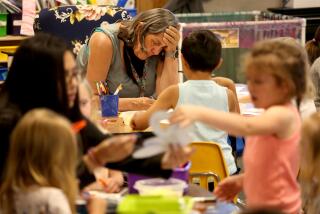Children Took Her Lessons to Heart
- Share via
ALBUQUERQUE — Well past nightfall on a recent Friday, Carolyn Rustvold’s car was still parked at Montezuma Elementary School, where she taught emotionally disturbed children. Her portable classroom was locked.
Her husband, Stephen, was near panic. He called friends, co-workers and finally the police. No one knew where Carolyn was. Stephen searched a nearby golf course until dawn, thinking she might have hurt herself jogging.
The next morning, a school security officer opened Carolyn’s classroom to a disturbing scene. Toys were strewn about; the wall clock was unplugged. Police detectives using special equipment found signs of blood everywhere. It was Carolyn’s blood.
Within hours, the school’s night janitor was arrested. Martin Saiz, 20, has been charged with murder. Carolyn’s body has yet to be found, and police presume it is somewhere in the surrounding desert.
The Jan. 17 killing, which police say must have been “extremely violent,” remains unexplained. Saiz, who has no criminal record, has refused to talk to police. Bloody clothes were found at his home.
The senselessness and brutality of the crime, and the fact that it took place in a school classroom, has shocked Albuquerque, where Carolyn’s husband, co-workers and friends remain grief-stricken.
But the reaction of her pupils has been a surprise and a comfort. Carolyn’s job had been to teach children ages 5 to 11 to manage their anger and depression. Since her death, it has become clear to those who knew her just how good Carolyn was at her job.
As an occupational therapist, Carolyn, 28, worked with about 50 emotionally disturbed children, the toughest such cases in the Albuquerque school district. With a soft, patient voice, she calmed the children. She made them giggle with her goofy hats and shirts that mixed stripes and plaids. And she taught them how to control their emotions.
After investigators left and the campus was scrubbed clean, the school’s staff prepared for the children’s return. Crisis counselors suggested children write letters and draw pictures to post on the outside of Carolyn’s classroom. Parents brought comfort foods and volunteered as classroom aides. The school held a memorial and a balloon release; the children cried.
Many teachers told their students that Carolyn “had disappeared and mostly likely had died,” said Julia Hogan, the assistant principal.
John Walker, a teacher who worked alongside Carolyn, said most of his students had already heard the news, so talk was blunt. “Some of our kids have seen murder first-hand in their lives already,” he said. Exposure to violent crime, he said, had triggered their behavioral problems.
“I told the kids that Carolyn had been murdered,” he said. “My personal goal was to not break down, but I did.”
When he delivered the news, some of the students sat quietly. Others contorted their faces in anger. One boy stormed into a “time-out room” in the classroom -- the size of a walk-in closet, its walls covered with soft flooring material, where students can scream or thrash about. To vent his anger, the boy did push-ups against the wall -- just as Carolyn had taught him.
Maura McWilliams, a speech pathologist, recalled how one troubled boy, who until Carolyn’s death had been unaware of how his actions affected others, drew a picture of a man, who represented Carolyn’s killer, enveloped in a sea of flames.
“But I would never do that to him,” the youngster said. “I wouldn’t want his family to hurt the way I do.”
“That was a huge breakthrough for this boy,” McWilliams said. “He showed the empathy that Carolyn had been working with him to develop. It was amazing.”
What surprised teachers was how the children “saw it as their job to help us,” McWilliams said. “One little boy followed me around campus, asking if I wanted to play with him so I’d feel better.” Her eyes grew teary at the recollection.
In the days following the killing, students wandered over to Carolyn’s portable at recess and silently studied it. After the first week, it was removed. Principal Deborah Detorie said the district offered to replace it but she declined. “That empty space represents the hole in our heart,” she said. “We’re not ready to fill it with a new building.”
In the six weeks since Carolyn’s murder, her husband, Stephen, still hasn’t deleted the answering machine greeting on his home phone, the one with her voice. He lays down a wedding portrait of his wife, and with trembling hands pushes his eyeglasses up and wipes the tears from his eyes.
He dreams vividly of her at night, dreams that turn into nightmares where she bids him farewell, and he shoots up in bed, eyes wide open.
Carolyn, a New Mexico college student, met Stephen, a truck driver, on a blind date while visiting Montana in 1997. Three years ago, after Carolyn graduated from the University of New Mexico, the couple married.
Carolyn was hired by the Albuquerque school district, working with children at a juvenile hall and at local hospitals. She transferred to Montezuma Elementary School two years ago. Her job allowed Stephen to return to school to study medicine.
Carolyn wanted to be a therapist to the world. She talked of adopting orphans from Asia, South America and Africa. “She wanted our home to be a little United Nations,” Stephen said.
In Carolyn’s memory, her family has set up a foundation, “Carolyn’s Causes,” to sponsor a summer camp for mentally disabled children.
Although the Rustvolds did not have children of their own, Carolyn’s pupils were, in a way, her children. And they have reached out to Stephen. They’ve given him their teddy bears, marbles and Legos, believing that sharing their toys will lighten his burden. One youngster sent Stephen a copy of his arithmetic homework to show how he’s still working hard at school, that life goes on and that Carolyn -- all the kids called her Carolyn -- would be proud.
One boy “gave me his home phone number and said he told his parents not to be surprised if I call him, just to talk,” Stephen said.
They also send him pictures. Some are simple scrawls, others more elaborate, with pipe cleaners and colored tissue. They are of rainbows, clouds, angels. There are crosses and hearts with fat tears.
In one letter, a boy wrote, “I’m very sorry this had to happen. If there is anything I can help with, please just come and ask for me in room 105.”
“Don’t feel bad that your wife died,” another child wrote. “She’s in heaven for all the good things she did.”
More to Read
Sign up for Essential California
The most important California stories and recommendations in your inbox every morning.
You may occasionally receive promotional content from the Los Angeles Times.










